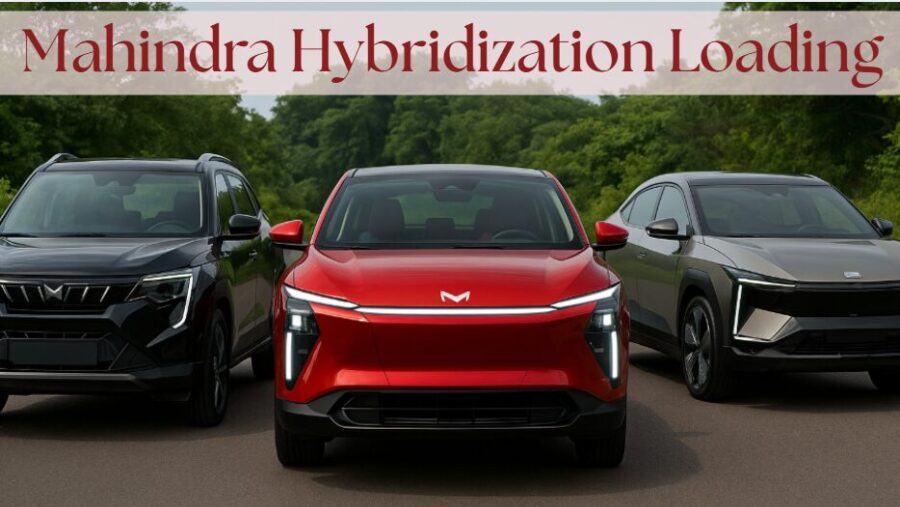Quick Overview: What’s Fueling Mahindra’s Hybrid Game Plan?
- Shift in Strategy: Mahindra rethinks its EV-only stance by exploring hybrid options.
- Two-Pronged Approach: ICE cars to get series-parallel hybrids; BEVs may use range-extender tech.
- XUV 3XO Hybrid Incoming: A 1.2L turbo-petrol strong hybrid is in development.
- India’s Hybrid Boom: With EV adoption slowing, hybrids are gaining momentum—and tax perks.
Mahindra’s Midway Move: From Pure EVs to Practical Hybrids
Mahindra, long seen as an electric-first automaker, is now changing lanes. While its Born-Electric platform made headlines and grabbed attention with futuristic EVs like the XUV.e9 and BE.05, 2025 marks a pivotal shift. Faced with slow EV growth and increasing hybrid demand, the Indian giant is now paving the way for a more balanced approach: hybridisation of both its ICE and EV platforms.
In a world where full electrification is proving tougher than expected—due to range anxiety, charging infrastructure, and high EV prices—hybrids are emerging as the smart middle path. And Mahindra is ready to plug in.
Dual Hybrid Strategy: One Goal, Two Technologies
So, what exactly is Mahindra planning?
Let’s break it down:
- For its ICE models, like the XUV 3XO, Mahindra is working on a series-parallel strong hybrid system. This means the petrol engine and electric motor can work together or independently, improving efficiency and reducing emissions.
- For its BEV lineup, Mahindra is eyeing a range-extender hybrid setup. Here, a 1.2-litre petrol engine doesn’t power the wheels—it works only as a generator, charging the battery which then drives the electric motor.
This clever approach gives customers the EV driving feel with added range security—perfect for India’s evolving infrastructure.
Coming Soon: XUV 3XO Hybrid
Mahindra’s compact SUV, the XUV 3XO, is set to become the brand’s hybrid flagbearer. Sources confirm that its existing 1.2L turbo-petrol engine will be paired with a strong hybrid system. Ideal for urban commuting and highway runs alike, this hybrid XUV could offer a compelling mix of performance, mileage, and lower running costs.
Mahindra has already tasted EV success—selling over 2,600 EVs in May 2025 alone—but aims to double that with hybrids in the mix.
Mahindra’s Hybrid Strategy Snapshot
| Platform Type | Hybrid Tech Used | Example Models | Engine Type |
|---|---|---|---|
| ICE | Series-Parallel Strong Hybrid | XUV 3XO (Upcoming) | 1.2L Turbo Petrol |
| BEV | Range Extender Hybrid | BE.05, BE.07 (Expected) | 1.2L Petrol (Generator Only) |
Why This Move Matters (And Makes Sense)
India’s EV dream is very much alive—but it’s a slow burn. Despite hitting a record 4% EV market share, the country is far from the 30% EV target by 2030. Meanwhile, hybrid sales are booming, backed by better availability and incentives.
In April 2025, nearly 8,754 hybrid cars and SUVs were sold—99% of which came from just two models: the Maruti Grand Vitara and Toyota Hyryder. These numbers prove that Indian buyers love fuel savings—but want the peace of mind that hybrids bring.
Even the government is sweetening the deal. States like Maharashtra and Haryana have begun offering road tax exemptions on hybrids, similar to EVs.
Conclusion: Mahindra’s Smart Move Could Redefine the Race
Mahindra’s pivot to hybrids is not a step back—it’s a leap toward realistic electrification. By offering both series-parallel and range-extender options, the brand is meeting Indian consumers where they are—between aspirations and affordability.
As rivals like Maruti, Toyota, Hyundai, and Skoda-VW prep their own hybrid launches, Mahindra’s timely entry could keep it right in the driver’s seat of India’s mobility revolution.
The road to electric may not be straight—but with hybrids, Mahindra is making sure it’s still a highway to the future.

